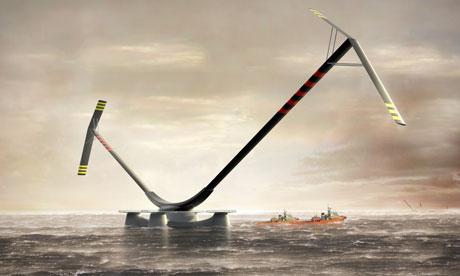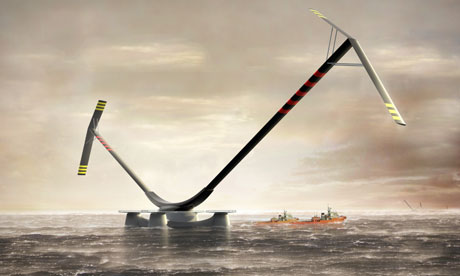There’s an oil spill in Michigan and the energy bill’s now a little slip of a thing, but a lot of other stuff happened in recent days that didn’t grab big headlines. Here are 10 stories from the greenosphere that you might have missed:
 The mammoth offshore wind turbine in development.Illustration: Wind Power Limited and GrimshawA really, really mighty wind: If wind power is truly going to be reliable and realize economies of scale, it needs to go offshore and it needs to go big, the thinking goes. Beyond big, actually. Massive. How massive? A British firm working on the next generation of offshore wind turbines has designed one that could provide electricity to 5,000 to 10,000 homes. It would stand almost 600 feet above the waves and have a wingspan of three football fields. John Vidal, writing for The Guardian, has more.
The mammoth offshore wind turbine in development.Illustration: Wind Power Limited and GrimshawA really, really mighty wind: If wind power is truly going to be reliable and realize economies of scale, it needs to go offshore and it needs to go big, the thinking goes. Beyond big, actually. Massive. How massive? A British firm working on the next generation of offshore wind turbines has designed one that could provide electricity to 5,000 to 10,000 homes. It would stand almost 600 feet above the waves and have a wingspan of three football fields. John Vidal, writing for The Guardian, has more.- Flush with power: The basic principle of renewable power, of course, is that you use sources of energy that will always be around: the sun … the wind … wastewater? British industrial design student Tom Broadbent started thinking about all the water that goes down the drains in a typical high-rise. That inspired him to create HyDro Power, a system that works like this: 1) Person takes shower or flushes toilet; 2) Water goes down drain; 3) On the way down, it hits four turbine blades; 4) Turning blades crank generator; 5) We get drain power. Maria Popova goes with the flow at Big Think.
- Tell it to the crabs: In answer to the question now being raised about the BP spill — “Where’s all the oil?” — scientists have at least part of an answer: it’s in crab larvae. Through much of the summer, they’ve been finding blobs of oil mixed with the chemical dispersant Corexit inside blue crab larvae. That means the toxic droplets have made their way into the food chain, since the larvae is a tasty treat for other marine life. Knowing that what you can’t see can’t hurt them, boosters of deepwater drilling can be expected to start reassuring us that this spill wasn’t so bad after all. Huffington Post’s Dan Froomkin shares a different story from under the sea.
- Unless, of course, Obama did it: Remember the chortling of climate-change deniers last winter when Washington, Baltimore, and Philadelphia were sitting under several feet of snow? It was Whack-a-Gore Week. But a new study by scientists at Columbia University, published in the journal Geophysical Research Letters, concludes that the whole mess wasn’t so surprising (and certainly doesn’t disprove global warming) — it was just the result of a quirky collision of weather patterns. “Snowy winters will happen regardless of climate change,” said climate scientist Richard Seager, lead author of the study. It may take a while for Fox News to get to this one, but you can get the lowdown from Columbia’s Earth Institute.
- Got juice? The Energy Department announced that it guaranteed a loan to build a new wind farm in Oahu, Hawaii. No big deal, right? But this isn’t your ordinary wind farm — it will be one of the first in the country to use a new kind of storage battery that ultimately could help power companies deal with the problem that the wind doesn’t always blow when you need it to. Matthew Wald of The New York Times explains how it would work.
- Matches? We don’t need no stinking matches: Shifting from winter in D.C. to summer in Moscow, the heat in the Russian capital this summer has been brutal enough — it hit an all-time high of 99 degrees F on Monday. But then there’s the smog, the kind of smog people will talk about years from now — if they live that long. As Russia’s chief lung doctor put it, the people of Moscow have been inhaling the equivalent of 40 cigarettes every few hours. Alexei Anishchuk of Reuters has the dirty details.
- The green, green blasts of home: On the East Coast, it’s been the kind of summer where the air conditioner becomes white noise, a constant, comforting hum that makes you forget it’s a power-sucking beast. That, of course, leads to the emission of more greenhouse gases, which brings more heat, which keeps the AC running, which … well, you get the picture. Fortunately, scientists are looking to stop the madness, or at least slow it down, by finding ways to green air conditioners, from replacing conventional refrigerants with CO2 to using sound waves. Helen Knight of New Scientist fills you in.
- It’s lonely at the bottom: You’re already at the bottom of the food chain, and now you find out that thanks to global warming — which, by the way, you’ve had nothing to do with — you’re dying off. Such is the plight of phytoplankton, those tiny plants eaten by not-quite-as-tiny sea creatures. After an extensive study of the transparency of seawater, a team of Canadian researchers found that the phytoplankton population has dropped about 40 percent since 1950. They ask for so little and now this? Lauren Morello, writing for ClimateWire, tells the sad story.
- Clean your plate: Scientists at the University of Texas estimate that in the U.S., more energy is used to produce the food we throw away than is available in the oil and gas reserves off our coasts. New Scientist does the math.
- Just fade away: For those who want to show that their commitment to a sustainable lifestyle doesn’t end when they do, there’s the Ecopod. It’s a coffin made of recycled newspaper and silk, along with mulberry leaves, and it comes in four designs: blue with doves, green with a Celtic cross, red with an Aztec sun, and gold leaf. Yuka Yoneda has more at Inhabit, and Agence France-Presse has this video.



